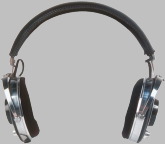Infrared Headphones
 Infrared headphones use infrared light to carry an information signal from a transmitter to a receiver. Sounds simple enough, but the actual process is very complicated. The human ear gathers sound as compression waves pass through and distort the air. These sympathetic distortions produce resonant vibrations in parts of the ear, which in turn trigger nerve impulses that are interpreted by the brain as various sounds. In no way is the human ear equipped to utilize either electrical impulses or beams of light as sound sources. Earphones 'translate' information from these sources into something that we can hear. In typical headphones, an electrical signal travels from the signal source to a pair of tiny speakers. The speakers contain a diaphragm attached to an electromagnet. As current through the electromagnet varies with the electrical signal from the source, the diaphragm vibrates in response. These vibrations translate through the air in the wearer's ear passages and into the ear.
Infrared headphones use infrared light to carry an information signal from a transmitter to a receiver. Sounds simple enough, but the actual process is very complicated. The human ear gathers sound as compression waves pass through and distort the air. These sympathetic distortions produce resonant vibrations in parts of the ear, which in turn trigger nerve impulses that are interpreted by the brain as various sounds. In no way is the human ear equipped to utilize either electrical impulses or beams of light as sound sources. Earphones 'translate' information from these sources into something that we can hear. In typical headphones, an electrical signal travels from the signal source to a pair of tiny speakers. The speakers contain a diaphragm attached to an electromagnet. As current through the electromagnet varies with the electrical signal from the source, the diaphragm vibrates in response. These vibrations translate through the air in the wearer's ear passages and into the ear.
In wireless headphones, the signal is carried by a beam of infrared light, rather than by solid wires. This requires the action of a 'translator' in the sending unit to convert the electrical signal from the source into a stream of data that can be expressed with infrared light. It also requires the action of an 'interpreter' in the receiving unit to convert the infrared data stream back into an electrical signal that will drive the small speakers of the headphones.
As a data carrying device, an infrared light source may seem quite limited. It can, after all, have only two operating states: 'on' and 'off'. Yet this simple limitation lends itself perfectly to digital transmission. In this mode, the analog signal from the source can be translated into a series of 'on' and 'off' signals, forming a digital data stream. Alternatively, the infrared light can serve as the carrier for a modulated signal. The modulation pattern of the light can mimic the on and off signals of the digital data stream. However the infrared light is utilized, it is emitted from the source, effectively 'broadcasting' its content, to be picked up by a receiving unit. The receiving unit is the infrared sensor on the TV, the VCR or DVD machine, or on the infrared headphone set. The transmitted signal thus captured is electronically 'decoded' and converted back into the corresponding electrical impulses that drive the tiny speakers in the headset.
About the Author
Richard M J Renneboog, MS
 Richard M. J. Renneboog is an independent private technical consultant and writer in both chemical and computer applications. Endeavors have included preparation of scripts for instructional and promotional video, corporate website design, curriculum development for training in advanced composites technology, and development.
Richard M. J. Renneboog is an independent private technical consultant and writer in both chemical and computer applications. Endeavors have included preparation of scripts for instructional and promotional video, corporate website design, curriculum development for training in advanced composites technology, and development.


